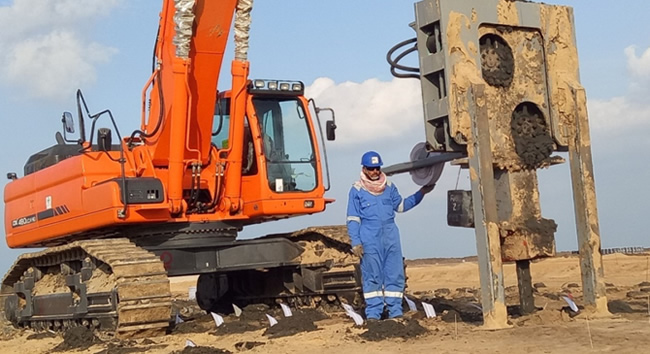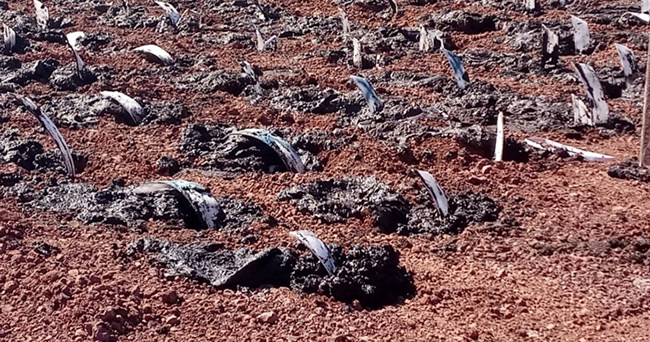By Namrata Bichewar – Prefabricated vertical drains are geocomposite drainage materials with an inner core of polypropylene wrapped in a nonwoven geotextile filter fabric. TechFab’s TechDrain PVDs are jointless versions of this high-performing class of products. The brand is available in corrugated and fishbone varieties.
All PVDs should have high permeability and a sufficiently high drainage capacity so that pore water escapes in the horizontal direction towards the nearest drain. Water then flows freely vertically along the drain to a drainage blanket placed on the soil surface or to a highly permeable layer above or below the clay layer.
Two international projects underscore the value of PVDs in today’s infrastructure projects.

33 million linear meters of PVDs were installed to support the first phase of the new industrial zone. Photo by Techfab India.
PVDS FOR PORT SAID, EGYPT INDUSTRIAL ZONE CONSTRUCTION
Port Said is one of the most important Egyptian ports on the Mediterranean Sea. Its location is strategic, being situated on the eastern entrance of the Suez Canal and in the middle of the biggest commercial navigational channel linking Europe with the East. It is one of the highest volume traffic ports in the world. Shipping container volume in Egypt overall grew by nearly 320% from 2000 – 2016, according to the World Bank.
The Suez Canal handled a good amount of that traffic. The Egyptian Government subsequently moved forward with soil improvement works as part of the first phase of the East Port Said Industrial Zone Project.
PVDs have been essential to the development.
The 1600 ha industrial zone is part of an ambitious plan to expand factory presence in the region by up to 1000. Key industries targeted by the developers include automotive assembly parts, building materials, appliances, electronics, textiles, and pharmaceutical.
Phase 1 involved 400 ha of the development and affiliated port works. Substantial soil improvement was required to achieve the proper bearing capacity.
Port Said is part of El Tina plain, which is composed of very soft to firm clays extending to depths up to 50 m. The contractor proposed expediting pre-consolidation of the soft clay by installing prefabricated vertical drains.
TechDrain-PVD (TD-3520U) was installed to depths between 25 and 30m. Over a 10-month span from 2016 into 2017, 33 million linear meters of PVDs were installed. This solution helped reduce construction time and cost. Techfab India Industries Ltd., the manufacturer of the PVDs, provided technical support to the works.
LIQUEFACTION MITIGATION FOR MEXICO AIRPORT
Editor’s Note: As of the publication of this story, the future of the new Mexico City airport remains in limbo, as President-elect Andrés Manuel López Obrador has announced a halting of construction work due to a recent referendum and rising cost concerns. Still, Geosynthetica supports the sharing of geotechnical case studies from the sites, as substantial engineering works have taken place and set up the challenging site for success. These are stories worth drawing upon in the future, regardless of what happens with the location. – Chris Kelsey, Editor-in-Chief, Geosynthetica

PVDs have reduced consolidation from years to months. 2.7 million linear meters of TechDrain PVD have been installed at the site of the new Mexico City airport. Photo by Techfab India.
Mexico City’s new international airport is being designed to be the biggest in the Americas and the third-largest in the world. The project is being developed by Mexico’s long-term transport development plan.
The existing Mexico City airport facilities are no longer sufficient to serve the ever-rising passenger traffic. The new airport will initially have double the capacity of the existing airport and will eventually able to handle four times the current volume.
The new airport is being constructed on federal lands near the former Lake Texcoco. The structure will be spread over an area of 4,430ha, which is under the purview of the National Water Commission. It’s a humid, marshy wetland. Like the Mexico City itself, the site was once an enormous lake drained by Spaniards after they colonized Mexico five centuries ago.
To support structures, the site’s muddy, unstable soils have needed to be consolidated. The time required for settlement would take years without PVDs; but, with geosynthetic drainage engineering, the consolidation time has been reduced to months.
As consolidation has progressed, an elaborate drainage system has also been built in. This dual construction process will enable the main terminal and its runways to handle the severe rainfall and even floods that can occur during Mexico City’s wet season.
TechFab has been supplied to the site since 2016. To date, 2.7 million linear meters of TechDrain PVD have been installed, reduced construction costs, and improved construction timelines.
Namrata Bichewar is a Design Engineer at TechFab India Industries Ltd., India. Learn more about the company’s geosynthetic technologies, engineering expertise, and global presence at www.techfabindia.com.










